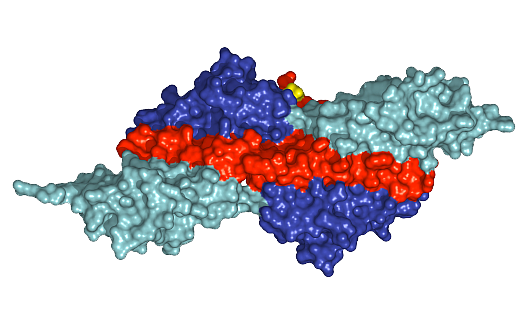What molecule am I?

Titin1, also called connectin, is the largest known protein. It is found in the striated muscle tissue of humans and other vertebrates; homologous proteins exist in invertebrate animal families. Human titin is >1 µm long and consists of 244 folded protein domains. Adults’ bodies contain ≈500 g of titin.
In 1954, Reiji Natori at the Jikei University School of Medicine (Tokyo) proposed an elastic structure in muscle to explain how muscles stretch and contract. The first comprehensive description of titin was reported in 1979 by Kuan Wang*, Janela McClure, and Ann Tu at the University of Texas at Austin. They used electrophoresis to purify “a combination of two uncommonly large proteins, designated as titin, from chicken breast myofibrils”. They concluded that titin is “a structurally conserved myofibrillar component of vertebrate and invertebrate striated muscles”.
Since the publication of Wang et al.’s pioneering work, a large body of research on titin has appeared. In 2019, Michael Gotthardt at the Max Delbrück Center for Molecular Medicine, the Charité University of Medicine, and the German Center for Cardiovascular Research (all in Berlin) and 11 collaborators in Germany, the United States, and Japan reported details of titin’s lifecycle: how it is biosynthesized and integrated into the sacromere (the smallest functional unit of striated muscle tissue), and how it eventually detaches and degrades. The authors stated that there is still much to learn about titin synthesis and assembly.
A ScienceDirect compilation provides examples of additional research on titin.
1. From “titan protein”. Not to be confused with tutin, the Molecule of the Week for May 2, 2022.
Molecules from the journals
Antimony oxide iodide (Sb5O7I)1 is a mixed antimony oxyhalide first synthesized in 1972 by Volker Krämer*, M. Schuhmacher, and R. Nitsche at the University of Freiburg (Germany). The researchers prepared Sb5O7I and other Sb(III)–O–I compounds by combining Sb2O3 and SbI3 in various ratios via a vapor transport procedure.
Crystalline Sb5O7I exhibits nonlinear-optical behavior. In September, Mei Yang, Wenlong Liu*, and Sheng-Ping Guo* at Yangzhou University (China) reported that Sb5O7I crystals with a 2-D hexagonal noncentrosymmetric structure show a direct optical energy gap of 3.22 eV, the largest among all reported ternary oxyiodides.
[Bis(trifluoroacetoxy)iodo]benzene2 [PIFA, from its alternative name phenyliodine bis(trifluoroacetate)] is an aromatic iodine(III)–trifluoroacetate compound that has become a valuable reagent in organic synthesis. It was first reported in 1973 by two research groups that used hypervalent iodine materials to study their reactions with silver salts and to prepare perfluoro- and perfluorochlorobenzenes.
PIFA is frequently used to carry out Hofmann rearrangements, in which it reacts with amides to eliminate carbon monoxide and form the corresponding amines. This September, in a sort of reversal to this reaction, Bill Morandi and co-workers at the Swiss Federal Institute of Technology (Zürich) used PIFA to add a nitrogen atom to indole derivatives to form quinoxalines.
1. CAS Reg. No. 37369-99-6.
2. CAS Reg. No. 2712-78-9.
Molecules from the Journals
MOTW briefly describes noteworthy molecules that appeared in recent ACS journal articles. See this week's
edition below.
This molecule was suggested by a reader. We present almost all of the molecules suggested by our readers. If you have a molecule you would like us to consider, please send us a message. And thank you for your interest in Molecule of the Week! —Ed.
Titin fast facts
| CAS Reg. No. | 219575-37-8 |
| SciFinder nomenclature | Titins |
| Empirical formula | C169,719H270,466 N45,688O52,238S911 |
| Molar mass | ≈3.815 x 106 g/mol |
| Appearance | See video |
| Melting point | Not reported |
| Water solubility | Portions soluble |

Learn more about this molecule from CAS, the most authoritative and comprehensive source for chemical information.
Molecule of the Week needs your suggestions!
If your favorite molecule is not in our archive, please send us a message. The molecule can be notable for its current or historical importance or for any quirky reason. Thank you!
Stay Ahead of the Chemistry Curve
Learn how ACS can help you stay ahead in the world of chemistry.

